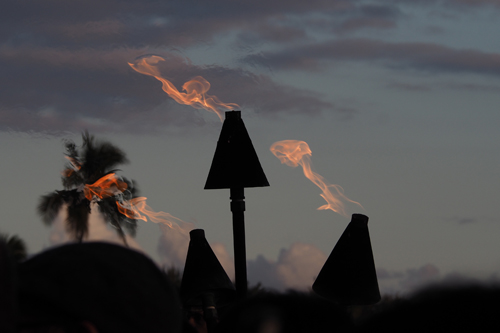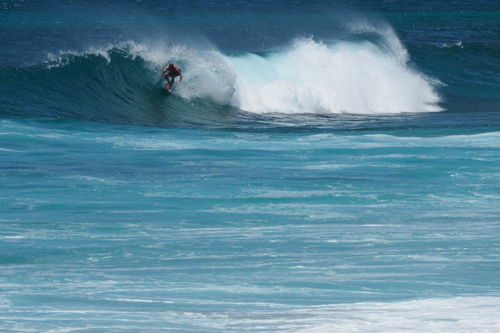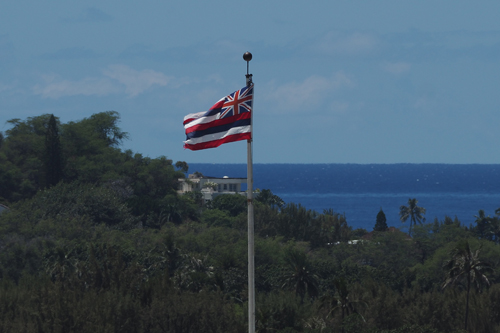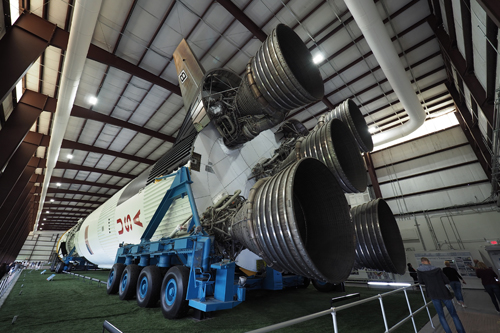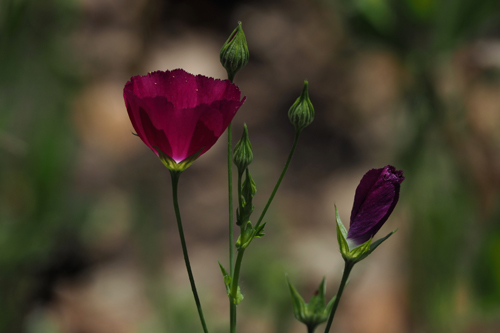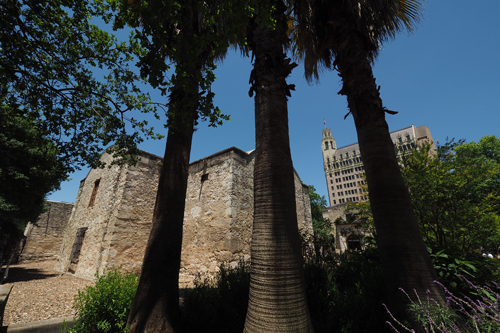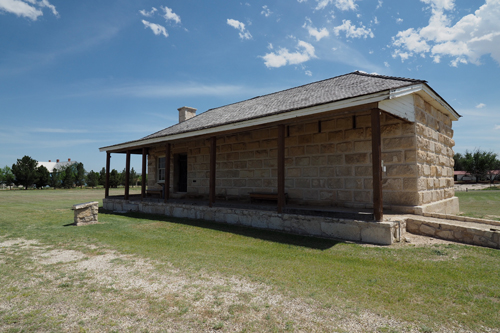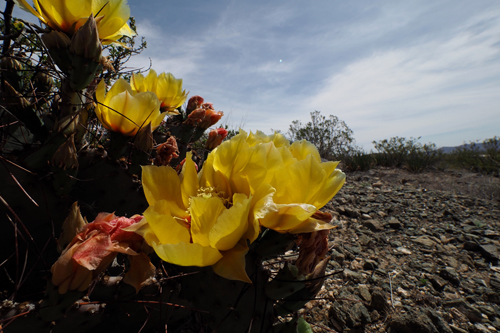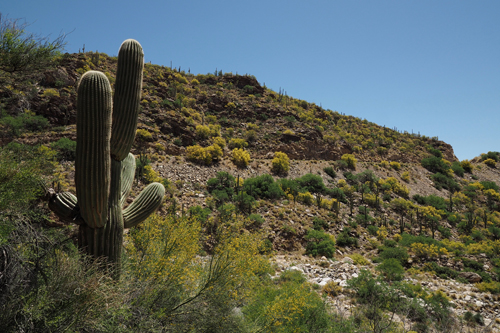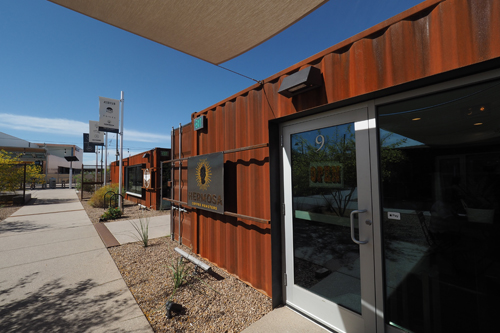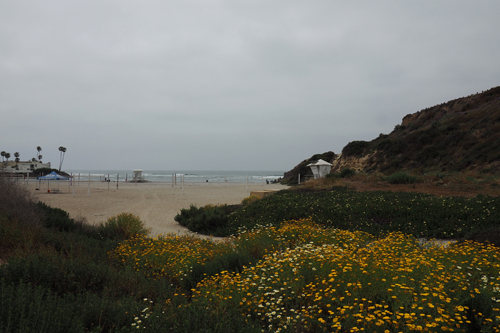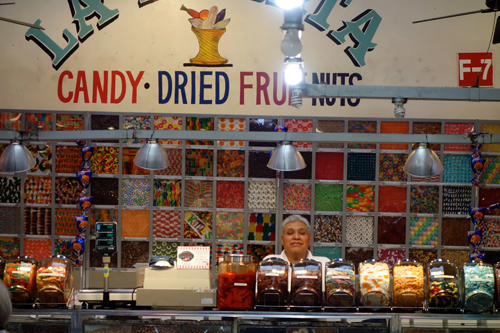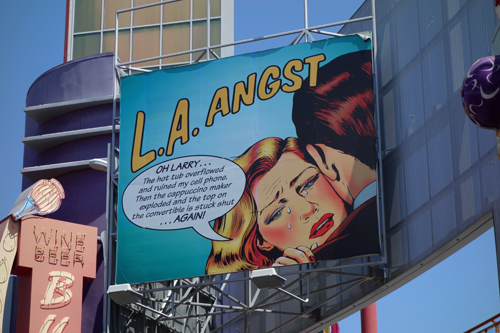May 6, 2019. Los Angeles, California to Honolulu,
Hawaii, USA.
Today we were leaving the continental United States and flying to Hawaii.
This was the final stage of our three months adventure.
Our trip to Honolulu took us via Kahalui. This was just a flight change for the very short journey to Honolulu, on the island of O’Ahu.
As we came into land I could make out surfers on the waves – well we were in Honolulu.
When we arrived I got the shock of my life to discover that there was an espresso bar and a craft brewery within the hotel complex. The coffee shop served coffee from locally roasted beans while the brewpub had a range of beers from Maui.
The Waikiki Beachcomber was right on the entertainment strip and just over the road from the famous surf beach. It was certainly in the thick of it, so there was no excuse for not enjoying our six nights there.
It had been a long day, as we were up at 5:30 in LA and had lost three hours along the way.
Once we had settled into the hotel we went for a walk around the area.
The first point of interest was a statue of Duke Paoa Kahanamoku (1890-1968).
Duke Kahanamoku was native Hawaiian, five-time Olympic medalist in swimming, who popularised the ancient Hawaiian sport of surfing.
Duke was his given name, he was also known as ‘The Big Kahuna’
In 1914 he put on an exhibition of surfing at Sydney’s Freshwater Beach. He did this on a board made from timber purchased at a local hardware store.
That was the introduction of surfing to Australia.
In 1925, while living in Newport Beach California, he rescued 8 men from a capsized fishing boat. He did this with the help of his surfboard, which then led to surfboards being used in off-the-beach rescues.
He was not only an athlete but also an actor and a law enforcement officer, serving 13 consecutive terms as the sheriff of Honolulu from 1932 to 1961.
A striking, more colonial, addition to the Waikiki beachfront is the Moama Surfrider Hotel. Built in 1901 it was the first hotel on Waikiki.
Naturally that night we ate at the Maui Brewing Co. They had an excellent selection of beers, as well as good wine and an extensive menu.
May 7, 2019. Honolulu, Hawaii, USA.
We had breakfast in the brew pub, yes they were open from 7am. There was fresh tropical juice plus Avocado on Toast.
The pub didn’t serve espresso coffee, we had to walk across the hotel foyer for that.
We then popped into Avis, which was next door, and arranged a rental for later in the week.
Part of our package with the hotel included free trolly bus rides, with unlimited use for the duration of our stay. The trolly takes two different routes around the Waikiki area and, depending on the driver, you get a guided tour as well.
There are a number of these trolleys, all provided by the hotel groups and even the airlines like JAL.
It seems to be a huge waste of resources as many of the busses passed by empty. I think that they could pool their resources and have one trolly system that ran more often and took everyone who had the passes.
We did one circuit to get a feeling of the city area then, on the next, hopped off at Diamond Head.
Diamond Head is a volcanic cone and it dominates the skyline behind Waikiki. The name was given to the volcano by the British, who believed that the calcite crystals found in the caldera were diamonds. The Hawaiian name, Lēahi, is far more fitting as it relates to the dorsal fin of a tuna. Which is exactly what the silhouette of the rim looks like.
Although the walk to the summit looked hard there were numerous switchbacks that made it relatively easy.
That evening, before dinner, we went to the free Kuhlo Beach Hula Show.
This was a narrated history, with dancers, of the hula in Hawaii. The hula was originally developed by the Polynesians who first settled in the Hawaiian Islands.
These dancers on Kuhlo Beach were much more conservatively dress than you see in the movies. I think that this had something to do with the strangle hold the missionaries had and still have on much of Hawaiian society. They saw the dance as heathen and pagan.
The show was an hour long and certainly worth it. The golden light of a fading sunset, the rumble of pounding surf, all set to the lilting tones of Hawaiian music.
Western cultures promote horse racing as the ‘Sport of Kings’. In Hawaii it’s surfing. The history of surfing in Hawaii goes back to the 4th century. When Polynesians migrated to the Hawaiian Islands they brought with them the art of board riding. It was belly boards to begin with then the long hardwood boards were used. The first sighting of a board rider by westerners was in 1779.
Surfing was a religious act and the Hawaiians would pray to their gods to find the good waves and seek inspiration on how to fashion the best boards.
The society was divided between noble people and the commoners. The nobles surfed on better breaks than the commoners and also had the superior and longer boards. Chiefs such as Kauai and Kamehameha were known for their ability and counted their surfboards amongst their most prized possessions.
These boards were enormous measuring over 7 metres (24 foot) in length.
When Captain James Cook arrived in 1778 he was closely followed by missionaries. Their strict religious piety, regarding clothing and their rules of only believing in their god, resulted in surfing almost dying out – just like hula dancing.
In 1905 things began to change when Duke Paoa Kahanamoku started a native surf club and revived the sport. Then in 1907 the author Jack London (1876-1916) and friends formed the Waikiki Swimming Club and opened up surfing to Westerners.
London was an atheist and social activist so it’s no wonder that he wasn’t concerned about offending the ‘faithful’.
It was London who coined the phrase ‘Sport of Kings’.
May 8, 2019. Honolulu, Hawaii, USA.
In Hawaii, or at least in Waikiki, we paid a Tourist Tax of US$30 per day, per room.
This gave us a number of benefits.
As well as free rides on the Trolly Bus, we also got discounts at certain restaurants. This encouraged us to share our patronage around a number of places.
For breakfast we went to the Hula Grill, just over the road.
The breakfast was good but their espresso machine had ‘broken down’ so it was back to the hotel cafe for coffee – again.
We then went for a long walk along the Waikiki beachfront, towards the base of Diamond Head.
The weather was rather overcast and threatened rain for most of the day.
Right along the beach there were surfers enjoying the small but consistent swell.
There are very few short board riders here, most tend to prefer the long boards. I guess this is partly due to the conditions but more to do with tradition.
Duke’s Waikiki is right on the water and across the road from our hotel. We tried to book there for dinner, on two occasions, but couldn’t get a decent time.
It’s a very popular restaurant.
Waikiki is a hybrid, something between a tourist town and a surf coast.
The streets are packed with tourists, of all shapes and sizes, many grossly overweight. There are three distinct groups, the mainland Americans are the largest, followed by the Japanese and finally the Australians, who are a substantial part of the mix.
They are obvious by their accents.
Then in the midst of this you get the surfers, male and female, young and old. All dressed in board shorts or bikinis, meandering along the main street, with their boards tucked under their arm and still soaking wet from their last wave.
Wherever we looked around Waikiki there were Hawaiian flags fluttering over the rooftops. They look more British Colonial than American, with the Union Jack sitting proudly in the top left corner.
This is a constant reminder of Hawaii’s past.
Hawaii was settled by Polynesians somewhere between 124 and 1120 AD: similar to New Zealand.
Captain Cook arrived in 1778 but there is a belief that the first European to set foot in Hawaii was the Spanish captain Ruy López de Villalobos in 1542.
American immigration quickly followed Cook, led by Protestant missionaries. The Americans were there to set up sugar plantations, much as they did in the Southern US.
Sugar was the prized crop, with markets spread around the world, and Hawaii had the ideal climate to cultivate it.
Unlike the US, slaves weren’t used as labor, instead immigrants were brought in from Japan, China and the Philippines.
The Americans, wanting more control, rewrote the constitution, limiting the power of the King ‘David’ Kalãkaua and weakening the native Hawaiian’s rights. In 1898 the islands were annexed by the US and became the Territory of Hawaii, then in 1959 they became the 50th state.
It’s little wonder that the Hawaiians prefer to have the Union Jack on their flag – that must really piss of the ‘patriots’.
May 9, 2019. Honolulu, Hawaii, USA.
We opted to drive around O’Ahu in a Nissan Versa. All the travel guides suggested that the best experience is in a Jeep Wrangler or Ford Mustang, both convertibles of course.
The Nissan was half the price and it was rather hot to have the roof down.
Besides soft top motoring is not that much of a novelty to us.
We stopped at the famous Banzai Pipeline. The surf was better in Waikiki, as there was only a small shore break at Banzai and nothing like the huge waves that are a hallmark of this well known break.
We didn’t get a lot of snaps on our trip as there is a shortage of good pull-offs and viewing points along the way.
On our return we tried to get a closer look at Pearl Harbour but found ourselves on a bridge heading towards the naval base. We were stopped, turned around and escorted off by a very pleasant security guard.
We were then sent on our way, but not before he checked my driver’s licence.
On the way back to Waikiki we drove through the downtown area of Honolulu, which isn’t very big, and stopped at the Iolani Palace.
Construction commenced in 1879. It was designed by Thomas Baker, in what became known as the American Florentine style. It was the home to Hawaiian royalty from its completion until 1893 and boasted electricity and a telephone, even before the White House.
After the overthrow of the monarch, in 1893, the palace became the capital building for the provisional government until 1969. It was restored in 1978 and then became a museum.
It still remains the only royal palace on US soil.
On our island excursion we drove 215.6 kilometres (134 miles) around O’Ahu. This isn’t much but then it’s not a large island.
May 10, 2019. Honolulu, Hawaii, USA.
We used the trolly bus again, this time to get down to Ala Moana Centre.
Built in 1959, It is regarded as the largest open-air shopping centre in the world.
It’s also the most valuable shopping mall in the US and one of the most valuable in the world
It is very large and I wonder if its world class status comes from the huge car park that is attached. There are 350 stores, restaurants and services spread over 220,000 square metres (2,400,000 square feet)
That night there were fireworks down on the beach. They were over in a flash and a bang and by the time we got there they were finished.
May 11, 2019. Honolulu, Hawaii, USA.
It was Saturday and our last full day in Honolulu. It was also the one day in the week that the KCC Farmers Market is operating.
Again we caught the trolly bus, which has a special market stop on Saturdays.
The market was primarily made up of food stalls but there was some fresh produce and flowers as well. It was also a place where there seemed to be more locals than tourists.
Wherever we went in Waikiki we seemed to come across ABC Stores. These aren’t operated by the Australian Broadcasting Commission but a chain of convenience stores that are based in Honolulu. They were opened in 1964 by the son of Japanese immigrant, Sidney Kosasa and sell a combination of groceries and tourist related items.
It’s not surprising that there are 178 hotels in Waikiki, what is a shock is that there are also 42 ABC stores.
There was a red carpet gala event being set up on Queen’s Beach, which is south of the main area, heading towards Diamond Head.
This was part of the premier of the 10th season of the new Hawaii Five-0 series.
The original police drama ran from 1968 till 1980. It was created by Leonard Freeman and stared Jack Lord (1920-1998) as Captain Steve McGarrett. Born in Brooklyn New York City he moved to Hawaii with the show. When Leonard Freeman died in 1974 Lord took over as executive producer.
McGarrett’s famous words, “Book ‘em Danno!” have become part of popular culture.
After the market we decided to go for a long Saturday lunch at Duke’s. This was our third attempt to get into this iconic beach side restaurant.
The chain of restaurants was named after the surfing legend Duke Kahanamoku and operates in Hawaii as well as California and Florida.
The food was just ok, however the location was stunning and worth the wait to get in. It’s practically on Waikiki Beach and you can watch the surfers catching the waves in front of you.
We had only a two minute wait when we arrived for lunch at 2pm, at 4pm the wait was twenty minutes and building.
Now large family groups were starting to pile through the doors.
Come 6pm and there would be no chance of getting a table at all.
The temperature has consistently been around 30°C, so it’s going to be a bit of a shock retuning to a Melbourne winter.
After being on the go for three months it was a great decision to have six, very relaxing, days in Honolulu.
May 12-13, 2019. Honolulu, Hawaii, USA to Melbourne via Sydney, Australia.
We were returning home and almost got caught out at the last turn.
It was very fortunate that we had one last coffee at our hotel in Waikiki, as the only one available at the airport, was at Starbucks.
We had travelled over 6,000 kilometres across America and not had to endure a Starbucks – I wasn’t going to start then.

